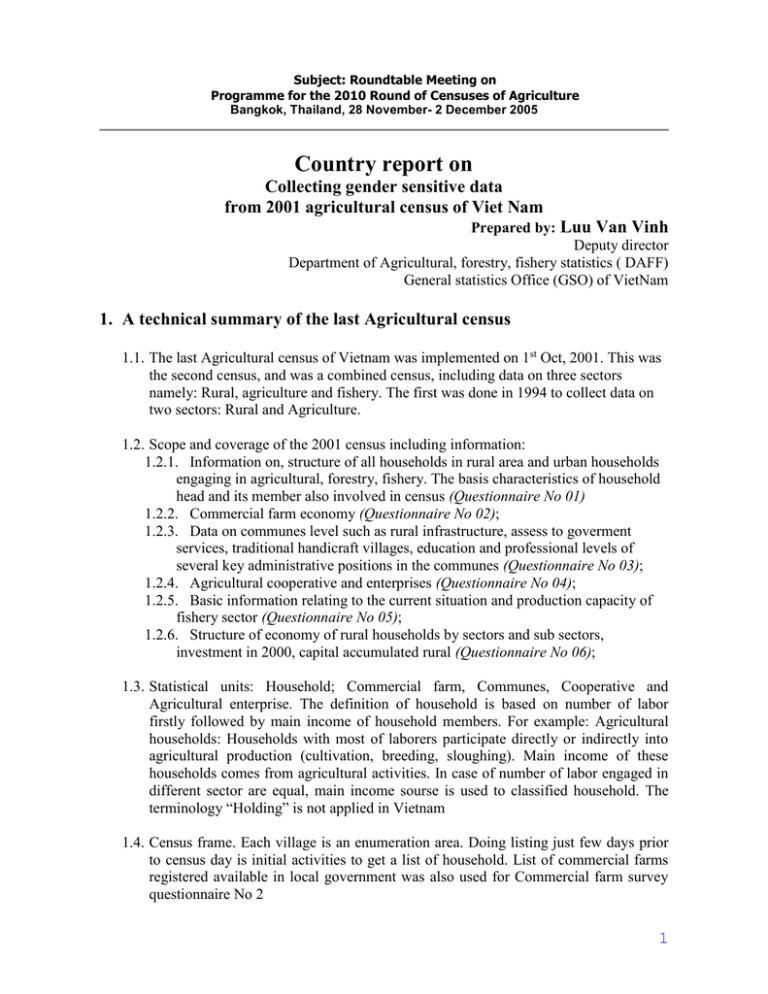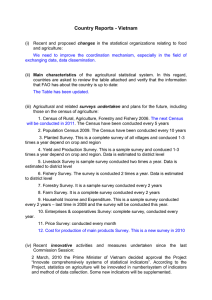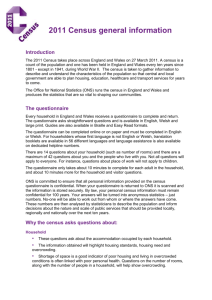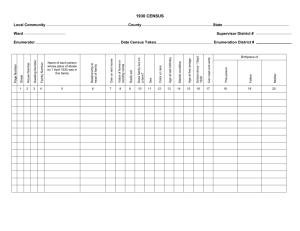Document 15931034
advertisement

Subject: Roundtable Meeting on Programme for the 2010 Round of Censuses of Agriculture Bangkok, Thailand, 28 November- 2 December 2005 Country report on Collecting gender sensitive data from 2001 agricultural census of Viet Nam Prepared by: Luu Van Vinh Deputy director Department of Agricultural, forestry, fishery statistics ( DAFF) General statistics Office (GSO) of VietNam 1. A technical summary of the last Agricultural census 1.1. The last Agricultural census of Vietnam was implemented on 1st Oct, 2001. This was the second census, and was a combined census, including data on three sectors namely: Rural, agriculture and fishery. The first was done in 1994 to collect data on two sectors: Rural and Agriculture. 1.2. Scope and coverage of the 2001 census including information: 1.2.1. Information on, structure of all households in rural area and urban households engaging in agricultural, forestry, fishery. The basis characteristics of household head and its member also involved in census (Questionnaire No 01) 1.2.2. Commercial farm economy (Questionnaire No 02); 1.2.3. Data on communes level such as rural infrastructure, assess to goverment services, traditional handicraft villages, education and professional levels of several key administrative positions in the communes (Questionnaire No 03); 1.2.4. Agricultural cooperative and enterprises (Questionnaire No 04); 1.2.5. Basic information relating to the current situation and production capacity of fishery sector (Questionnaire No 05); 1.2.6. Structure of economy of rural households by sectors and sub sectors, investment in 2000, capital accumulated rural (Questionnaire No 06); 1.3. Statistical units: Household; Commercial farm, Communes, Cooperative and Agricultural enterprise. The definition of household is based on number of labor firstly followed by main income of household members. For example: Agricultural households: Households with most of laborers participate directly or indirectly into agricultural production (cultivation, breeding, sloughing). Main income of these households comes from agricultural activities. In case of number of labor engaged in different sector are equal, main income sourse is used to classified household. The terminology “Holding” is not applied in Vietnam 1.4. Census frame. Each village is an enumeration area. Doing listing just few days prior to census day is initial activities to get a list of household. List of commercial farms registered available in local government was also used for Commercial farm survey questionnaire No 2 1 1.5. Data collection methodology: Completed enumeration applied to items 1.2.1-1.2.5. And sampling of 1% rural households for item 1.2.6 1.6. Time for data collection is within 30 days during 1st- 30 October 2001. Reference time for data: Point-of-time information: Actual data will be collected as of 1st October 2001; Period-of-time information: is data on 2000 or data to on last 12 months depending on the specific variables and units of the survey. 1.7. Interview of head of household (farm) in economic was applied. And all household member over 13 years old excluding school pupils and disable work people. 1.8. Enumerators is village official who undertaken an intensive training for data collection of Questionnaire No 01. Households was be given a prior notice of the date and time visited by enumerators. Data collectors for other questionnaire surveyed such as communes, co-operatives, farms and enterprises were advised to designate professional staff who have certain knowledge of the locality to directly gather data and information 1.9. Post_ census: A random sample of 3% of questionnaire No1 was re_ surveyed for assessing the reliability of the data collected and calculating non sampling errors 1.10. Data processing: Data capture was done in 57/61 provinces. Data processing was done in GSO headquarter. Time for releasing final data was 15 months. 1.11. Data available for users is hard copy and CD. Raw database also was constructed. 2. Gender data collection 2.1. Vietnamese law regulates that women are equal to men in all socioeconomic activities, especially in rural areas 2.2. Vietnam is an agricultural country; 76% of the population lives in rural areas and more than 70% of the labor is engaged in agriculture. In rural areas, women within the working age account for 51% of the population and 54% of the labor force. It is clear that women are the main force taking part in small-scale industrial production and service activities in rural areas. Therefore, women have greatly contributed to the achievements of the Vietnamese agriculture and rural areas in the renovation period 2.3. Gender issue has just paid attention in Vietnam recently and Gender statistics also was a fresh activity in GSO 2.4. Gender statistics also involved in 2001 census of Vietnam, but not too much. This is a one of biggest limitation that was found by data users in their analysis on role of women in rural agricultural and fishery sector. The issue of gender analysis from census data was not concerned just as phases of census preparation. Therefore not all variable that could be classified by sex was designed in the census questionnaires 2.5. The information on head of household by sex was not collected in the 2001 census of Vietnam. It is clearly that the identification of head of household not provide the basis 2 for comparing the characteristics of household managed by men and women in analyzing aspects such as land use, cropping patterns, and use of different agricultural practices, income resource, livestock...and the problems faced by women in rural and agricultural sector 2.6. However, information on all of household member who are in laboring age (male 1560 and female 15- 55 years old) but able to work was collected more detail on: Age Sex Occupation training level Primary economic activity Secondary economic activities 2.7. The follow is a partly extract of questionnaire in household level in 2001 census. This provides users many information on women labor by age, education and economic sector for gender analysis Only for the person in working age but able to work Sex Name of household member A B Month, Year of birth 1 Male=1 Female= 2 2 Occupation training Level Activities during last 12 months Primary activity Secondary activities - Agriculture = 1 No training yet/ no -Certificate = 1 - Primary =2 - Secondary = 3 - College = 4 - Uni. And over = 5 - Forestry = 2 - Fishery =3 Ind, handicraft = 4 - Construction = 5 - Commercial = 6 - Transportation = 7 - Other services = 8 - Workless = 9 3 4 (For one activity of spending most time) (Code as the same column 4) 5 1 2 3 4 5 2.8. Commercial farm plays an important role in development progress of countryside and poverty reduction. Number of commercial farms in Vietnam is now growing. Information on female-owned farms and their operation was collected in Questionnaire No 2 used to collect data on commercial farms. Below is its extract 3 Part I: Identification of commercial farm 1. Name of farm owner:......................................................................... 1.1 Sex Male = 1 Female =2 1.2 Class status of farm owner Official = 1; Farmer = 2; Others = 3 1.3 Professional level of farm owner Primary education =1; Middle and college =2; University and over =3 2. Establishing year: 3. Type of economic activity: Annual crop 1 Forestry: 4 Perennial tree 2 Aquaculture: 5 Animal husbandry: 3 Mix business 6 2.9. In 2001 census information on Sex, Age, Education and Occupation training of women who took an important leading position of local government in commune level also was collected shown in a part of the questionnaire No 3 as following Part IV: Educational and Professional level of major commune members Code Sex Age Educational level Professional level 1 2 3 4 A B The Secretary of Party 1 The Chairman of commune council 2 The Chairman of commune committee 3 The Vice Chairman on duty of commune committee The Chief of farmer commune association 4 5 Code: Column 1: Male =1; Female=2; Column 3: Primary school = 1; Middle school = 2; High school = 3 Column 4: Junior =1; Colleague, Intermediate = 2; University and up =3 2.10. Information on women who took responsibilities on cooperative management also was collected in 2001 agricultural census of Viet Nam. However it is still enough information due to the gender issue has not been appropriately considering. 4 3. The changes in gender in next census 3.1. In keeping with the Goal 3 of the MDGs acknowledges the promotion of gender equality and empowerment of women as key elements in advancing social and economic progress and VietNam Government policy on women especially women in rural, agricultural and fishery sector, GSO had a new planning in gender statistic. 3.2. The purpose of this statistics planning is aiming at providing data user all variable that could be classified by men and women. That is why all questionnaire used in any survey and census implemented by GSO have to put more attention on gender statistics, and all variable related to labor, head of household ...have to classified by man and women. 3.3. VietNam will conduct the third rural, agricultural and fishery census on 1st July 2006. We are now in preparation phase. The 7 questionnaire that will be used in 2006 census have drafted and ready for pilot test in December 2005 3.4. Methodology of the 2006 census will be the same as the 2001 census. The coverage also is the same. The content is wider including information on production cost of some main crop and animal. 3.5. During questionnaire designing phase, information on gender, sustainable development, assess to community services by household and many other data on commune and village level also are involving the questionnaire set. Data on household level is collected not only by sex but also be ethnic group. It is useful for poverty analysis in remote area and other study 3.6. The information on gender that was found in the 2001 census that mentioned in above part will also be in the 2006 census. The variable by sex that omitted from the 2001 census such as head of household by sex, labor operated in commercial farm by sex... will be added in the 2006 census 3.7. Variables in all 7 questionnaire of the 2006 census will be tabulated by sex separately in data processing and tabulation planning to make it more convenient for data users. Raw database by sex also is available for subject_mater analysis and special gender survey in future. 3.8. A study on WCA 2010 that has just been downloaded from FAO website is undertaken by GSO for the 2006 questionnaire addition and finalization before pilot test not only for gender issue but other themes as FAO recommendation in the documents to maximum international comperation 3.9. Data on the sex, age, education, economic activity, main income source of each household member over 13 years old. Data on sub-sector and sub-holders that introduced for the first time in WCA 2010 is not involving the 2006 census of Vietnam. I may be collected in other surveys 5 3.10. The follow is a partly draft extract of questionnaire No 1 in household level of the 2006 census to make a comparison of change in the gender themes between two census in Viet Nam Sex: Male=1, Female=2 Head of household:.................................... Ethnic.............. Part I: Household, Population and labor 1. Population and labor : 1.1. Polulation of HH: 1.2. Person in working age: Only for the person over 13 years old age but able to work Occupation Activities during last 12 training months Level Primary activity Two Sex Secondary - Agriculture = 1 Name of household Month, Male=1 No training yet/ no - Forestry = 2 activities member - Fishery =3 Year of Female= -Certificate = 1 Spending - Primary =2 Ind, handicraft = 4 2 birth most time - Secondary = 3 Maim income during last 12 months (Code as the same - Construction = 5 (Code as the column - College = 4 - Commercial = 6 same - Uni. And over = 5 - Transportation = 7 4) column 4) - Other services = 8 - Workless = 9 A 1 2 3 4 5 B 1 2 3 4 1 2 5 6 / / / / / Note: This is draft questionnaire No 1 for 2006 Agricultural census in VietNam 3.11. A plan of gender analysis using 2006 data census is a main activities of GSO after census data collection. 6 7




